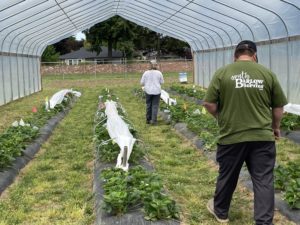Aug 12, 2022Low tunnels aid strawberry growth, protect from disease and pests
Due to the cold, wet spring in western Oregon, the fruit hadn’t ripened at Strawberry Field Day in June at Oregon State University’s North Willamette Research and Extension Center (NWREC) in Aurora.
Under experimental plastic tunnels, however, the berries were quickly catching up.


The low tunnels – semi-permanent structures made of clear plastic sheeting draped over hoops – are designed to cover a single row and protect crops from rain and extend the season, said Erica Chernoh, assistant professor of practice and head of the OSU Extension Berry Initiative.
Field trials at NWREC and other research locations have shown that the tunnels are successful at extending the strawberry season for day-neutral cultivars, Chernoh said. Temperatures are higher underneath the plastic and the plants are protected from the rain, which spreads disease as rain splashes the spores splash onto the plants. A new two-year study will compare low tunnels to high tunnels.
“We hope we can provide growers with some tools they can use to extend their harvest season to produce fruit outside of the typical season when competition is high and to help meet the market demand for fresh strawberries grown locally in Oregon,” Chernoh said.
Indeed, there is a great potential for fresh market strawberry production in Oregon, where most of the strawberry harvest is processed rather than sold whole. Growers want to produce fresh, locally grown fruit for the market, which people say they want, Chernoh said.
“There was a market analysis done by the nonprofit Oregon Tilth that found there is a demand for fresh strawberries that’s not being met by Oregon growers,” said Chernoh, who took over the Berry Initiative in 2021 after working for three years as a collaborator.
“There’s an opportunity for Oregon growers to fill that market,” she said. “A lot of fruit is imported from out of state and comes to the supermarket at 75% ripeness. We will never compete with the scale of strawberry production in California, but we can produce a great-tasting and fresh Oregon berry that’s available in local markets more than just a few weeks in the summer.”
That’s where the tunnels come in. The research, which initially focused on low tunnels under former Extension specialist Javier Fernandez-Salvador, showed they resulted in an extended strawberry growing season.
“We’d like to see the season of day-neutral strawberries extend through late October; that’s the goal,” said Chernoh, who previously worked with strawberry growers in Sacramento County for two years as part of the University of California Cooperative Extension.
“In the 2019 harvest we were picking fruit until Thanksgiving. We’d like to get an earlier season, too, so growers could harvest in late April or early May rather than late May or early June,” she said. “We’d get extension on either side of the current season.”
High tunnels have the potential to perform the same as low tunnels or perhaps better. Chernoh’s latest research concentrates on a comparison of low and high tunnels, which look similar to greenhouses without the electricity and water. Low tunnels, on the other hand, cover a single row of crops right above the plants. She plants popular day-neutral strawberries Albion and Seascape in both tunnels, as well as open field, and maintains them with the same soil conditions, water and fertilizer.
The study focuses on organic production so no synthetic pesticides are used, though an organic product was applied for the dreaded spotted wing drosophila, an invasive fruit fly that has given Oregon growers headaches for more than a decade. Overall, insect and disease pressure are managed because her team uses an integrated pest management approach that includes sanitary measures like adequate space between plants and weeding to eliminate host plants and competition with the strawberries. They also use a bug vacuum for control of insect pests and trapping for field mice. The tunnels protect the plants from rain, which reduces fruit rot and disease pressure.
Chernoh said she thinks the high tunnels will yield more and have a longer season, but that’s still to be seen. High tunnels are more expensive to build than low tunnels, so may be more accessible to large-scale growers. The low tunnels are made with less expensive materials that, except for the plastic, are easily available at local hardware stores. The Extension publication “Low Tunnels for Season Extension in Oregon: Design, Construction and Costs” is a starting point.
The OSU Extension Berry Initiative has been supported by Oregon Legislature since 2017. A grant from the Northwest Center for Small Fruits Research provides funding for the current season.
—Kym Pokorny, OSU Extension
TOP PHOTO: Strawberry Field Day attendees look at low plastic tunnel field trials at the North Willamette Research and Extension Center.















